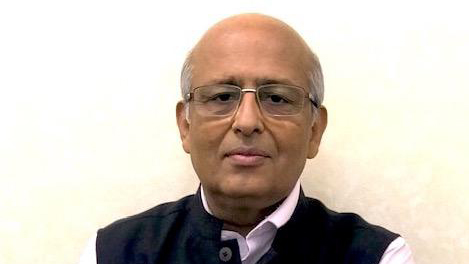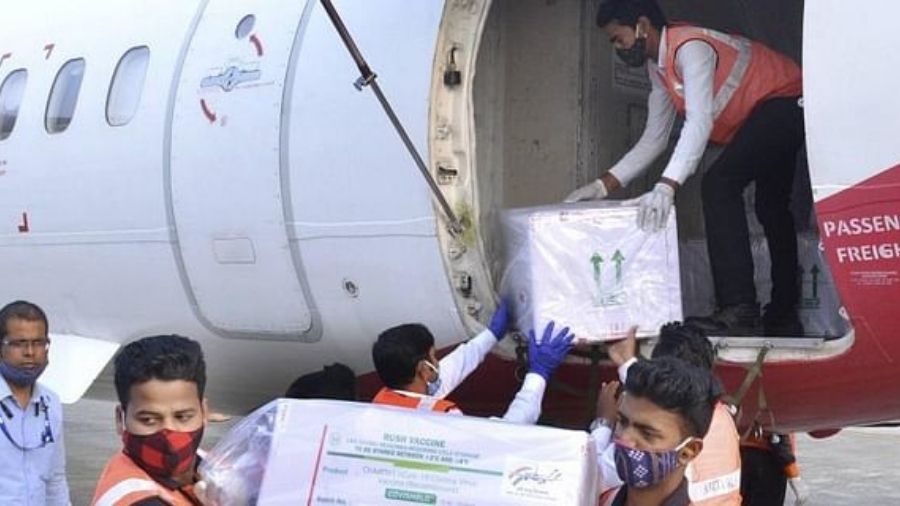With the highly contagious Omicron threatening to sweep India, it’s urgent for the central government to scale up Covid-19 vaccine production and approve a booster-jab programme before it’s "too late", says top Indian virologist Shahid Jameel.
Jameel’s call came after Dr V.K. Paul, who heads the government’s Covid-19 task force, warned late last week that “if we see the number of cases in the UK,” which is reeling from a surge in Covid-19 cases, “it would translate to 1.4 million cases a day in India.”
Jameel, one of the leading scientific voices during the pandemic, said that “unless they make a policy now, approve and ramp up the protein vaccine production immediately, we’d be too late” in rolling out booster shots.

Indian virologist Dr Shahid Jameel. Wikipedia
Omicron is believed to be 25 to 50 times more transmissible than the Delta variant which was much more contagious than the original Wuhan virus. Models worldwide forecast that Omicron will supplant the Delta variant. In the US, which has been hit badly by the pandemic, public health experts are warning that Omicron may push the number of infections to their highest level yet seen in the country. It’s still unclear though whether the surge in Omicron cases will be followed by a huge number of hospitalisations.
Data gaps in detection
Let’s go over India’s defences against the variant sweeping the globe and which was first detected in this country on December 2. As of Sunday, the country had reported 126 cases of Omicron, though scientists warn that there could be large “data gaps” in detecting instances of the virus due to a lack of capacity to sequence pathogen genomes. They say the variant could be spreading in India and not being caught. “With limited genome sequencing capabilities, genomic sequencing cannot be a “diagnostic tool. Every individual cannot be tested,” Paul says.
Two doses of vaccine have shown themselves to be much less effective in fighting Omicron than against previous variants. Also, Omicron is better at escaping the immune system protection conferred by vaccines or earlier infection. On immune resistance, a study by London’s Imperial College found protection from Covid-19 afforded by a past infection nosedived to 19 per cent, compared to 85 per cent with other variants. Similarly, vaccine efficacy slid to between zero and 20 per cent after a two-dose course of the AstraZeneca (branded as Covishield in India) or Pfizer vaccines.
Booster the best option
But three doses of vaccine significantly fortify the body’s ability to fight the virus, scientists say. In fact, obtaining a Covid-19 booster, US models suggest, is the best action a twice-jabbed person can take to protect against the variant.
So where are we in India on that third dose? The government has said it wants to vaccinate the entire adult population. Around 75 per cent of India’s population or 940 million are adults and 25 per cent are under 18. So far, 52 per cent of adults have received two doses. To complete the two-dose vaccination of adults, India needs 726 million doses of vaccine, Jameel says.
The production capacity per month is 250-275 million doses for Covishield and 30-40 million doses for Covaxin. If the government allows 25 per cent to be exported, according to its current schedule, the local capacity is per month is about 190 million doses for Covishield and 22 million doses for Covaxin. “At this production capacity, it will take three to four months of vaccine supply of both vaccines to achieve total coverage of India’s 18-plus population,” Jameel notes.
Govt yet to place orders
The government has around 167 million doses of vaccine on hand. That is sufficient for 83 million people. The Serum Institute of India which makes Covishield has 250 million in stock and says it could supply another 250 million over the coming couple of months. But here’s the catch. Chief executive Adar Poonawalla says that the government hasn’t placed any new vaccine orders with the company.

Unloading of vaccination shipment at an airport. Twitter
Bharat Biotech, which makes Covaxin, and which is a far smaller vaccine player, can supply around 55-60 million doses a month. Add all those numbers up and you have 660 million doses.
Now, here’s the next piece of information to take on board. If you’ve had two doses of Covishield, a third jab of Covishield isn’t going to help your immune system fight off Covid that much. Covishield employs a chimpanzee adenovirus as a vector to deliver the virus protein into the body to trigger an immune reaction. “Repeated boosters with that (Covishield) will mean boosting chimp protein responses at the cost of spike protein responses,” Jameel says.
The only other game in town is Covaxin. Some 89.9 per cent of the population has received Covishield. But that vaccine (Covaxin) and Bharat Biotech’s production capacity is far less than the Serum Institute’s.
Dispute over immunity
Pfizer and Moderna which are preferred for use as boosters in the rest aren’t available here due to a dispute over civil suit immunity. Pfizer and Moderna have been asking to be shielded from any legal suits that could result from adverse side-effects, a demand that the government has rejected. There are other vaccines but they’re still either not being used or haven’t been cleared.
Zydus Cadila’s DNA vaccine ZyCoV-D was cleared by the regulator four months ago but still hasn’t been included as part of the immunisation programme. Zydus Cadila had said that it would be able to manufacture up to 40 million doses by December.
There is also an mRNA vaccine made by Gennova Biopharmaceuticals which is in phase two-three trials that are expected to wind up in January. And there’s the protein vaccine Corbevax manufactured by Biological E and its trial findings are being delivered on a real-time basis to the regulator. Jameel says the regulatory process needs to be accelerated.
Also, there’s Serum Institute’s Covovax, developed by US biotech firm Novavax, which just got WHO clearance. Novavax has a deal with Serum to manufacture 2 billion doses of the vaccine which copies the coronavirus’s spike protein, triggering an immune response that readies a person to fight a real infection. Last month the government sought additional data from Serum Institute on Covovax.
Priority: vaccinate all
If the government decided right now to permit booster shots, the bottom line is that there is only Covaxin to use for the overwhelming number of Indians who’ve received Covishield. “The priority should be to first vaccinate all adults with two doses. Booster doses come next, starting with health and frontline workers. However, modelling studies show that there is enough benefit in giving boosters to elderly and people with immunodeficiencies, who are at increased risk for severe disease,” says Jameel.

The booster dose has to be opted (for) when there is appropriate evidence, Paul says. File picture
Now, how bad is Omicron? Worryingly, two new analyses in UK say preliminary findings provide no signs of Omicron being milder. One of them found the chances of being hospitalised with Omicron and Delta may be similar. But health officials in South Africa offered some contradictory data, indicating the disease manifested less severely in the country, but they also stressed these were early findings. South Africa’s government said the fatality ratio among ages, calculated at day 25 of infection, of people with Omicron was one-third of the numbers seen during the previous two waves in the country.
Wait and watch
The government appears to be adopting a wait-and-watch approach. “A new phase of the pandemic is being experienced in Europe. We have to ensure the European situation does not occur in India and we don’t see a spread like theirs. Conversely, we have to be prepared for this situation,” Paul says.
On booster doses, Paul was decidedly non-committal. “The booster dose has to be opted (for) when there is appropriate evidence,” he says.










